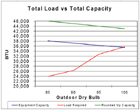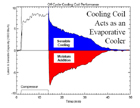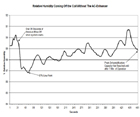
The AC-Enhancer®, invented by David Mathews, is a solid-state device that installs in the control wiring between the thermostat and the air handler or gas furnace.
According to Mathews, this device takes control of the system to reduce start-up inefficiencies every time the system starts.
MEASURING EFFICIENCY
The federal government currently measures efficiency based primarily on the SEER rating system. Manufacturers have come behind legislation and government mandates to create high-SEER, high-efficiency systems.“Manufacturers have made great strides in pushing the envelope to increase the SEER rating of new equipment,” lauded Mathews.
“They have increased the surface area of evaporator coils, increased the fins per inch, made the fins thinner, and even created enhanced surface area fins, all to increase the heat transfer capabilities of the cooling coils. They have also reduced the capacity of the outdoor compressors and increased the condenser coil sizes to help increase SEER ratings.”
Though encouraged by the strides taken within the industry to increase efficiency via SEER ratings, Mathews argues that comfort is not measured strictly in degrees of temperature, but that it is measured as a combination of temperature and rh.
“Just like comfort cannot be measured by temperature alone, efficiency cannot be measured by SEER rating alone,” he said.
“We, as an industry, have trained the consumer to focus on SEER as the guideline for efficiency, and we have ignored some of the other factors that really play a major role in the comfort of our customers.”
According to Mathews, the SEER rating of an air conditioning system does not take into account the dehumidification capacity or lack thereof within a system.
“We, as contractors, have been taught to subtract the sensible capacity from the total capacity and assume that the result is the latent capacity of the system,” he noted. “The problem with this is that the capacities listed are for steady state operation of the equipment in a laboratory setting. They do not take into account the start-up or partial-load cycling of the system. The calculated latent capacity of the system also does not take into account the re-evaporation of moisture removed from the space during start-up and shut down.”
OVERCOMING OBSTACLES
Looking to overcome some of the new situational obstacles surfacing as heating and cooling technology is enhanced, Mathews’ AC-Enhancer was created. The unit has built-in logic allowing it to know if the system is in heating or cooling mode, and then it adjusts its sequence of operation accordingly.“It virtually eliminates the burst of cold air in the winter time when the heat pump starts in heating mode by allowing the coil to warm up before the blower is brought on,” explained Mathews. “If the fan is set to continuous operation for airflow or filtration of the space, the AC-Enhancer holds the fan off completely at the end of the cooling cycle for 10 minutes to allow the majority of the moisture to run off the coil before the fan is allowed to come back on.”
To help eliminate the re-evaporation of the moisture that is held on the coils at start-up, the control forces the evaporator coil to get down to the dew point temperature or lower before the fan is allowed to activate.
“Holding the blower off initially at start-up will also help the compressor to start with a reduced load so that it will reach its peak efficiency faster,” said Mathews. “Then, once the blower is brought on, it needs to come on at a reduced speed so that it will not allow the evaporator coil to warm back up above the dew point before the temperature levels out. Also, the system must be brought up to its full blower speed in a short enough time period so that the equipment and ductwork don’t get so cold that they start condensing moisture on them.”
According to Mathews, at the end of the cooling cycle, the blower needs to be turned off within a couple of seconds of the condensing unit cycling off so as to eliminate the re-evaporation at the end of the cycle, too.
DEVICE NOT INCLUDED
Manufacturers don’t incorporate this technology because the AC-Enhancer actually reduces the equipment’s SEER rating by defeating the forced on blower at the end of the cooling cycle.“However, because the AC-Enhancer drastically decreases the amount of removed moisture that is re-evaporated into the space and reduces the time it takes the compressor to reach its peak efficiency, the actual delivered efficiency is increased,” said Mathews. “When using the control, the delivered latent capacity of the system is increased and the occupants feel more comfortable. In many cases, this increased comfort allows them to turn the thermostat setting warmer than they would without it.”
The AC-Enhancer works on most systems, including variable-speed blowers as well as standard multi-speed PSC motors.
“My idea was to build one unit that works on most all systems to reduce inventory stocking problems for the contractor,” Mathews explained. “About the only system that it does not work on are communicating systems and mercury bulb thermostats.”
Mathews advises occupants that the moisture that is re-evaporated into the space when not using the AC-Enhancer is moisture that they have already paid to remove.
David Mathews is the owner of CCAC Inc. in Corpus Christi, Texas. His company specializes in residential and light commercial replacement and service. To view some of his research, see the sidebar below. For more information, visit www.theacenhancer.com or contact Mathews at david@ccac-ac.com.

Figure 1. (Click on the image for an enlarged view.)
Sidebar: Facts and Figures
[Editor’s Note: The following facts and figures were provided by David Mathews to further explain his research.]In Figure 1, the blue line shows the total Btu output of a 3-ton 15 SEER system. Notice that at 100°F outdoor temperature the output is just slightly less than 36,000 Btu. The red line shows the actual load requirements of the space. Notice that at 100° outside temperature the load and the capacity of the system are almost exactly equal. The problem is that as the outside temperature goes down, the capacity of the system goes up and the load on the space goes down. At 85° outside, the capacity of the system is about 14,000 Btu, or more than a ton, over the actual load requirements of the space. When running a load calculation we as contractors are taught to always round up the capacity requirements, plus we are sizing for an outdoor temperature that only occurs less than 5 percent of the time in our climate zone. The green line in Figure 1 shows the effect of rounding up the system to the next size. It displays that at 85° outside we are now a little over 22,000 Btu oversized.

Figure 2. (Click on the image for an enlarged view.)

Figure 3. (Click on the image for an enlarged view.)

Figure 4. (Click on the image for an enlarged view.)

Figure 5. (Click on the image for an enlarged view.)
Publication date:05/25/2009


Report Abusive Comment